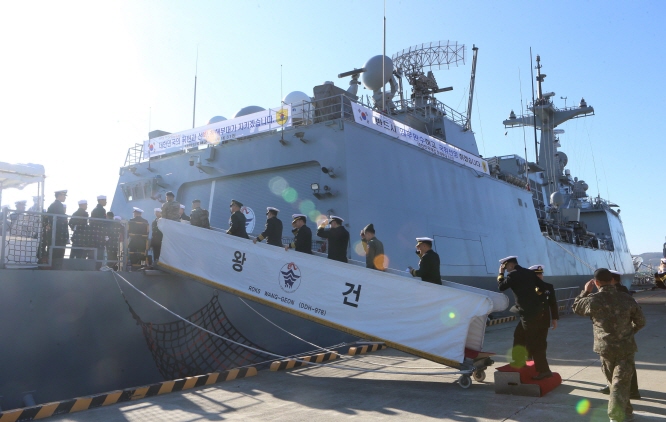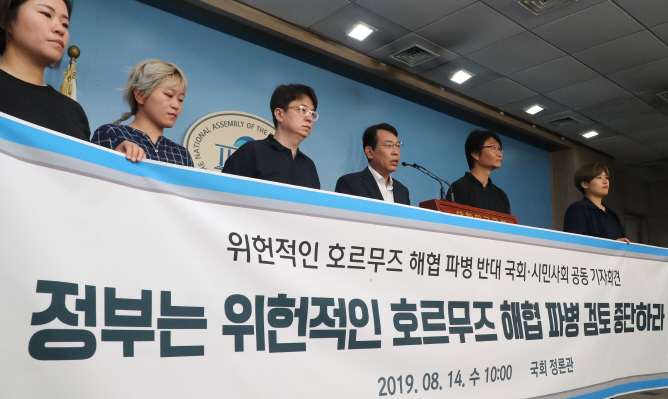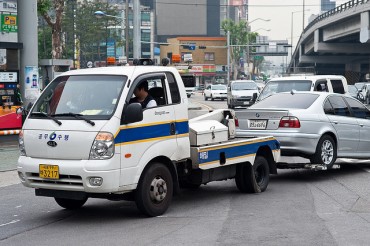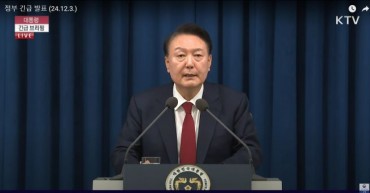
The 300-strong 31st contingent of the Cheonghae Unit holds a send-off ceremony at a naval base in South Korea’s largest port city of Busan on Dec. 27, 2019, before leaving for the Gulf of Aden to combat piracy in waters off Somalia over the next six months aboard the Wang Geon, a 4,500-ton destroyer. (Yonhap)
SEOUL, Jan. 21 (Korea Bizwire) — South Korea will dispatch troops to the Strait of Hormuz by expanding operational areas of its anti-piracy unit deployed nearby to help protect its vessels passing through the strategic waterway, the defense ministry announced Tuesday.
The forces, however, will not join a U.S.-led coalition, but conduct independent operations, the ministry said, a move seen as reflecting Seoul’s consideration of relations with Tehran and Washington’s request for contribution to its campaign to secure the waters off Iran.
“In consideration of the current situation in the Middle East, the government has decided to temporarily expand the Cheonghae Unit’s sphere of activity in order to guarantee safety of our people and the freedom of navigation of our vessels,” the ministry said in a release.
The 300-strong Cheonghae Unit, which has been on an anti-piracy mission in the Gulf of Aden off Somalia since 2009, will broaden its mission areas into the Gulf of Oman, and further to the Persian Gulf, starting Tuesday, as the 31st batch of the rotational troops along with the 4,400-ton destroyer, the Wang Geon, is to assume the role on the day, according to the ministry.
While the Cheonghae Unit will act on its own, two liaison officers affiliated with the unit to the U.S.-led International Maritime Security Construct (IMSC) “for cooperation such as information sharing,” the ministry said. The IMSC is headquartered in Bahrain.
“Since May last year, when tensions began to heighten in the Middle East, we’ve been reviewing diverse options,” a senior defense ministry official said, adding that the government prioritizes the safety of South Korean people and vessels.
As the world’s most important oil passageway and a choke point between the Arabian Gulf and the Gulf of Oman, the strait is the route to the open ocean for more than one-sixth of global oil production and 70 percent of South Korea’s oil imports.
Some 25,000 South Koreans reside in the Middle East, and around 170 South Korean ships sail through Hormuz about 900 times per year, according to government data.
Tensions in the region have mounted since Iran launched missile attacks on U.S. troops in Iraq earlier this month in retaliation for a U.S. airstrike that killed a top Iranian general.
Before announcing the decision, the ministry had consultations with the U.S. and also explained reasons for the decision to Iran through diplomatic channels, according to the official.
“The U.S. side welcomed the move, and I’ve heard that Iran said it understands Seoul’s stance,” he said.
When the Seoul government notified Iran of its decision over the weekend, Teheran expressed concern as it is basically opposed to any deployment of foreign troops or vessels to the region, according to a foreign ministry official here.
“(We believe) efforts should be made to manage ties between South Korea and Iran, and the Iranian side has responded the same way on that,” the official said, adding that Seoul has been reviewing various options to improve the relationship.
In order to carry out missions in broader zones, the military equipped the destroyer with additional arms such as anti-submarine weapons, anti-aircraft guns and sonar compared to its previous configuration, according to a military officer.
The Cheonghae unit will increase the length of that route it patrols to around 4,000 kilometers from the original 1,350 kilometers.
“We’ve made preparations for possible missions in the Hormuz Strait. But Cheonghae’s basic missions — anti-piracy activities and escorting ships — remain unchanged,” the officer said.
As for the meaning of the “temporary” expansion of its role, the ministry official said it will be valid “until situations in the Middle East improve.”
The decision does not require parliamentary consent, as the law stipulates that the unit shall carry out missions in the Gulf of Aden and its surrounding regions.
It is also allowed to launch activities in “designated waters” to protect citizens in case of emergency.

Rep. Kim Jong-dae (3rd from R) holding a press conference on Aug. 14, 2019, calling for the government to stop considering troop dispatch to the Strait of Hormuz. (Yonhap)
It will be the first time since 2004 that South Korea has dispatched troops overseas upon the U.S.’ request. That year, South Korea deployed the Zaytun unit as part of the U.S. campaign in Iraq.
Some experts say the decision could serve as a bargaining chip for South Korea in its negotiations with the U.S. on their sharing of the cost for the upkeep of American troops here.
Washington has reportedly demanded a drastic increase in Seoul’s payments this year.
South Korea has footed the bill for the deployment of the Cheonghae Unit that reaches around 32.5 billion won (US$27.8 million) per year, according to the officials.
But the foreign ministry here rejected any linkage between the two issues, with spokesperson Kim In-chul saying during a regular briefing that the dispatch “flatly has nothing to do” with the defense cost-sharing deal.
Currently, more than 1,100 South Korean troops are operating on overseas missions in 12 countries for reconstruction, armistice monitoring and other peacekeeping missions.
The troops include those in the Dongmyeong Unit operating as part of the U.N. Interim Forces in Lebanon; the Hanbit Unit for peacekeeping operations in South Sudan; and the Akh Unit in the United Arab Emirates, with a mission to train UAE troops and protect South Korean nationals in the Middle Eastern country in case of emergencies.
(Yonhap)






